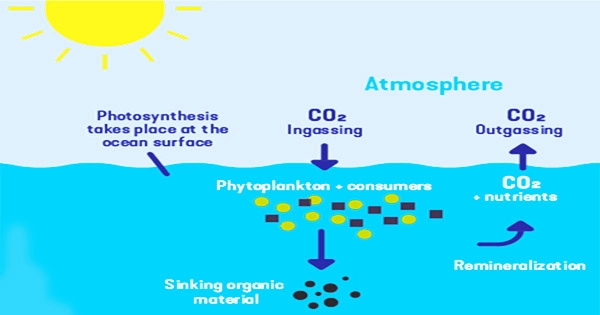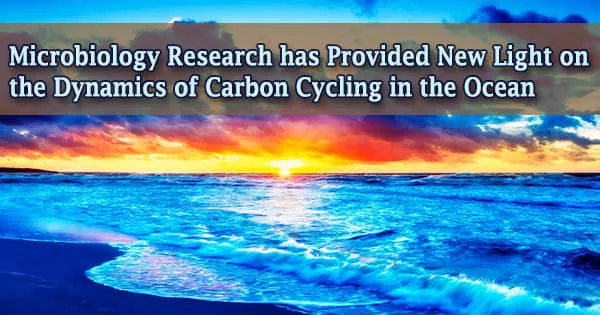Microbiology experts at Oregon State University used a unique way to identify which microorganisms are eating different forms of organic carbon generated by common phytoplankton species, shedding fresh information on the dynamics of carbon cycling in the ocean.
The research is an important step toward forecasting how much carbon will leave the ocean for the atmosphere as greenhouse gas carbon dioxide and how much will end up entombed in marine sediments.
Ryan Mueller
According to Ryan Mueller, associate professor in OSU’s Department of Microbiology and the study’s lead author, “the research is an important step toward forecasting how much carbon will leave the ocean for the atmosphere as greenhouse gas carbon dioxide and how much will end up entombed in marine sediments.” The results of the study were published in the Proceedings of the National Academy of Sciences today.
“Our research shows that different species of microbes in the ocean are very particular yet predictable in the food sources they prefer to eat,” said first author Brandon Kieft, a recent Oregon State Ph.D. graduate who is now a postdoctoral researcher at the University of British Columbia. “The availability of food supplies for microorganisms will shift as global climate change continues to modify marine habitats at a rapid rate, favoring certain species over others.”

The ocean is important for global carbon cycling for three reasons: (1) it is a large carbon reservoir with a quick turnover time; (2) carbon dioxide in seawater is effectively dissociated inorganically into other substances; and (3) marine plankton keeps the surface ocean carbon dioxide concentration at a lower level than a lifeless ocean.
Phytoplankton are tiny creatures that live at the bottom of the ocean’s food chain and are an important component of a biological carbon pump. The majority of them float near the surface of the water, where sunlight can easily reach them.
By sucking in carbon dioxide during photosynthesis, the small autotrophic plants that create their own food have a significant impact on the amounts of carbon dioxide in the atmosphere. It’s a natural sink and one of the main ways CO2, the most prevalent greenhouse gas, gets removed from the atmosphere; CO2 levels in the atmosphere have risen by 40% since the industrial revolution, adding significantly to global warming.
“We’re studying the consumers the heterotrophic microbes of the organic material made by the primary producers, the microbial phytoplankton,” Mueller said.
“Both are microorganisms, however, the former primarily eats organic carbon as a food source, whilst the latter ‘fixes’ organic carbon on their own. Microbes are the foundation of the food web and biological carbon pump, and our research focuses on how consumers interact with this system.”
Nearly as much carbon is stored in the surface ocean as there is in the atmosphere. As the ocean absorbs carbon dioxide from the atmosphere, phytoplankton converts the CO2 and sunlight into sugars and other molecules that cells may utilize for energy, creating oxygen in the process.
This so-called fixed carbon is consumed by heterotrophic microorganisms and higher marine food web creatures like fish and mammals, who then convert the carbon to atmospheric CO2 through respiration or add to the carbon pool at the ocean’s bottom when they die and sink. The principal method that fixed dissolved organic carbon from phytoplankton is recycled to the atmosphere as CO2 is through the collective respiratory activity of heterotrophic microbial consumers.
Mueller, Kieft, and colleagues at the Oak Ridge and Lawrence Livermore national laboratories, as well as the universities of Tennessee, Washington, and Oklahoma, used stable isotope labeling to track carbon as it entered the organic matter produced by phytoplankton and, eventually, the heterotrophic microbes that consume it.
These isotopes were used to determine which creatures were eating diatoms and which were eating cyanobacteria, two phytoplankton species that together provide the bulk of the ocean’s fixed carbon. The researchers could also detect when the consumption was taking place since the phytoplankton cells were occasionally creating lysates during their death phase or exudates during their growth phase.
“Our findings have important implications for understanding how marine microbes and photosynthetic algae function together to impact global carbon cycling and how this oceanic food web may respond to continued environmental change,” Kieft said.
“This will help us predict how much carbon will go back into the atmosphere and how much will be buried in marine sediments for centuries.”
The ocean is the most important sink for anthropogenic carbon dioxide over the intermediate to long time periods. The kinetics of carbon dioxide absorption in the oceans function on a longer time scale than the present and predicted human emissions. The Gordon and Betty Moore Foundation Marine Biology Initiative and the US Department of Energy financed the study.





